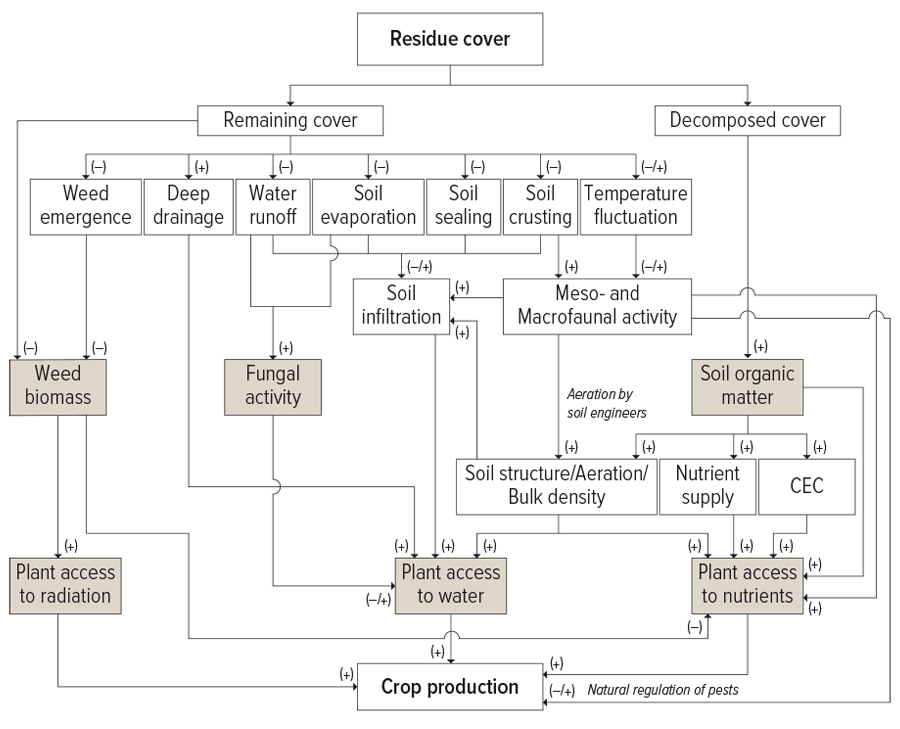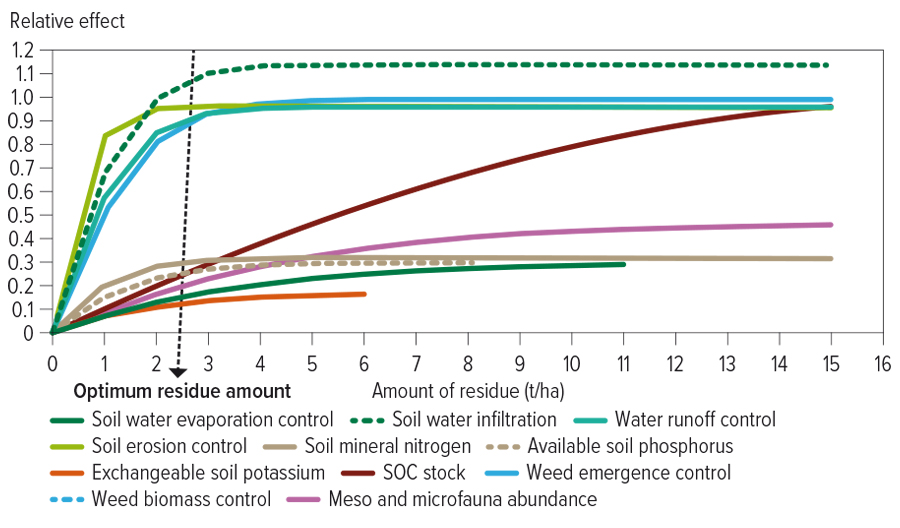Decisions on how best to manage stubble at harvest, over summer and at seeding can have potentially significant impacts on farm productivity. This includes effects on soil organic matter levels, erosion risk, soil moisture, weed levels, disease levels and, ultimately, farm profit.
There are, however, important gaps in our knowledge about the complex dynamics associated with stubble that need to be addressed if we are to optimise stubble management decisions.
With investment from GRDC, the Western Australian No-Tillage Farmers Association (WANTFA) has produced Stubble Retention, a guide that summarises current information on the optimal way to manage stubble. Included in the guide is a summary of the scientific literature in addition to local research, grower case studies and lessons learnt from GRDC’s Stubble Initiative.
This effort to curate and bring together information on stubble management has helped to identify knowledge gaps and, therefore, opportunities to target research in ways that close the gaps and bring about significant extra gain for growers. An overview of the stubble-related factors that affect crop production is given in Figure 1.
A short overview of what is known and what we need to learn is provided here.

Figure 1: Crop residue parameters that affect crop production. Source: Derived from Ranaivoson et al, Agronomy for Sustainable Development. 2017, 37, 26.
Soil water
Overall, the impacts of stubble on soil water dynamics are site-specific and its effects are negligible during long dry spells in fallow or extremely wet environments. Results are not consistent in terms of the optimum amount, architecture or deposition of stubble. Simple generalisations are not possible given the variability of rainfall and complexities associated with soil type and soil water loss processes.
Studies with both the Agricultural Production Systems sIMulator (APSIM) and Simultaneous Heat and Water (SHAW) agricultural systems computer models, however, found that simulations based on real climate data can improve recommendations about best practice in each region when it comes to managing stubble for soil moisture benefits.
Opportunities also exist to further calibrate these models. Of particular benefit is data from regional investigations on the optimal amount of residue, its architecture and decomposition. Once linked to the associated yield and crop emergence responses, there could be a role for computer modelling to help inform best management practice.
Weeds
Crop residue can influence weed ecology, with impacts varying depending on the stubble’s quantity and position as well as the weed’s specific biology and allelopathic potential (the residue’s ability to produce biochemicals that affect weed growth). Most studies, however, have focused only on stubble amounts and types. None have reported on the impact of residue cut height, orientation or location in the row/inter-row space in terms of impacts on weed ecology.
Additionally, crop residues can intercept 15 to 80 per cent of applied pre-emergent herbicides, which reduces the amount of active chemical reaching the soil surface to kill germinating seedlings. It is, therefore, important to evaluate new herbicides for efficacy in different stubble situations, particularly to identify the chemicals that adsorb into the stubble and do not ‘wash off’ on to the soil. Knowing this will allow crop stubble architecture and load to be better managed to improve herbicide efficacy.
With the rapid uptake of integrated weed management, future research could focus on weed seed predation and decay within practices such as chaff decking or chaff lining.
Microorganisms
Disease
Residue-borne diseases can be a problem under stubble-retained systems, particularly when similar crops are grown in succession. Research has highlighted the importance of the local environment and type of cropping system in determining disease risk associated with stubble retention.
For example, in WA, crop rotations as short as one year are enough to control yellow spot (Pyrenophora tritici-repentis) and Septoria nodorum blotch (Phaeosphaeria nodorum) in these dry environments. In contrast, in northern NSW, wheat yellow leaf spot survived longer under more humid conditions. In this case, a two to three-year break was recommended for stubble retention systems.
The impacts of stubble orientation and cut height on disease dispersion also vary according to the pathogen and the environment, making it challenging to generate general conclusions on diseases such as yellow spot, crown rot and blackleg.
A better understanding of the trade-off between stubble management for optimal yield and for disease management is needed so the appropriate fungicide management strategy can be determined.
Beneficial organisms
Stubble conservation systems are known to increase beneficial microbial and fungal populations that suppress soil and stubble-borne diseases.
Research in SA and eastern Australia showed some control of Rhizoctonia root rot (Rhizoctonia solani) and take-all (G. graminis var. tritici) in ‘suppressive soils’, indicating that suppression can develop after five to 10 years of no-till and stubble-retained management.
The development of suppressive populations was found to be independent of the rotation but rather arises through changes in soil composition brought about by stubble quality that promotes high carbon turnover and low nitrogen mineralisation. Further work is needed to explore potential applications under different stubble management strategies and over longer time frames.
Meso and macrofauna
While it is known that pests and beneficial insects react differently to no-till systems, the best residue management practice to promote soil fauna under the stubble layer is still unknown. What is known is that crop residue retention could be the most effective practice for enhancing soil biodiversity.
For example, studies have found that ants and termites increase wheat yield by up to 36 per cent by increasing soil water infiltration due to their tunnels. They also improved soil nitrogen. As such, they play a similar functional role to earthworms.
The possibility of supporting ants and termites within long-term no-till paddocks is the most under-researched idea that may help increase production in the medium to low-rainfall zones.
Emergence and yield
The current average wheat yield in Australia (of about 2.2 tonnes per hectare) generates about 3.3t/ha of residue (harvest index of 0.4), but this may vary from less than one to more than 9t/ha of residue (for 6t/ha grain yield). While some studies have reported yield increases with increased stubble amount, others have found a negative relationship.
Yield increases can be attributed to enhanced water infiltration, improved soil structure and the control of soil erosion, plus the minimisation of both absolute levels of and fluctuation in soil temperature. Yield losses are ascribed to the immobilisation of mineral nitrogen, reduced soil and air temperatures (mainly during crop emergence), physical impairment and possible phytotoxic effects.
With a few exceptions, results indicate that there is an optimal amount of stubble when it comes to maximising dryland wheat yields. Below or above this optimal band, crop yields could decline. However, research is still needed to quantify optimum levels and to identify the key mechanisms of growth reductions for each crop in a rotation.
There are further gaps around the effect of very tall stubble and an overall need to link yield studies with our understanding of stubble management impacts on water dynamics, nutrition and soil/air temperature.
Nutrient availability
Accounting for the impact of crop residue on nutrient availability remains one of the greatest challenges due to the complex nature of nutrient recycling pathways.
What is known is that short periods of net nitrogen immobilisation can occur following the addition of crop residue to the soil surface due to microbial biomass increases in response to the additional carbon substrate. Other studies show that when high amounts of stubble are retained, stubble may tie up nitrogen from applied fertiliser during the decomposition, mainly when the fertiliser is broadcast.
It has been reported by CSIRO’s Dr John Kirkegaard that nitrogen tie-up increases during high-rainfall seasons (above 300 millimetres), causing yield reductions of 0.3 to 0.5t/ha. Cereal-on-cereal is most at risk. He suggests reducing stubble loads or applying more nitrogen (at about five kilograms per t/ha of cereal residue) to overcome these yield penalties.
More work is needed to understand the nitrogen budget in relation to stubble type, age, orientation and stubble-derived nitrogen contributions. This information can additionally be used in modelling crop rotations or used in tools for nitrogen management.
Temperature
Information on stubble impacts during heat stress is limited from a local and global perspective. From the total reviewed papers in our database, no research has correlated stubble management (amount, cut heights, location) with soil and air heat stress during the reproductive phases of different crops. More research is a priority. By contrast, there is research showing certain stubble management practices can be used to avoid crop damage in frost-prone regions.
Optimising residue levels through modelling and monitoring
The concept of an ‘optimum level’ of residue is complex to unravel and needs to be analysed for each growing environment and farm condition. A critical stubble threshold has been reported in a project that included 110 case studies from tropical and temperate regions and several residue types, including wheat, maize and rice.
As presented in Figure 2, the residue threshold value of 2 to 3t/ha shows a near-maximum impact on most of the predicted functions. The boundary lines located at the bottom of the figure confirm that soil fauna abundance, soil water evaporation control and soil nutrient availability had a relatively low response to increasing amounts of surface residues.

Figure 2: The maximum effect of surface crop residues in relation to their amount for a set of agroecological functions. Source: Derived from Ranaivoson et al, Agronomy for Sustainable Development. 2017, 37, 26.
On the other hand, the potential maximum effect of crop residues on soil water infiltration, water runoff and soil loss control was large. Weed emergence and biomass control and soil organic carbon stock also increased with increasing amounts of residue. This kind of analysis could be used to optimise stubble management and also be included in existing computer models, such as APSIM.
Future research should focus on three aspects:
- Develop optimising models to predict the optimal profit level of residue for each environment as expressed in Figure 2.
- Develop sensing tools that monitor residue levels across the farm so managers can assess stubble levels and future strategies to optimise their levels.
- Delineate the impact of stubble on heat stress during the reproductive stage of grain crops.
More information: David Minkey, David.minkey@wantfa.com; WA Stubble Retention guide.

























































